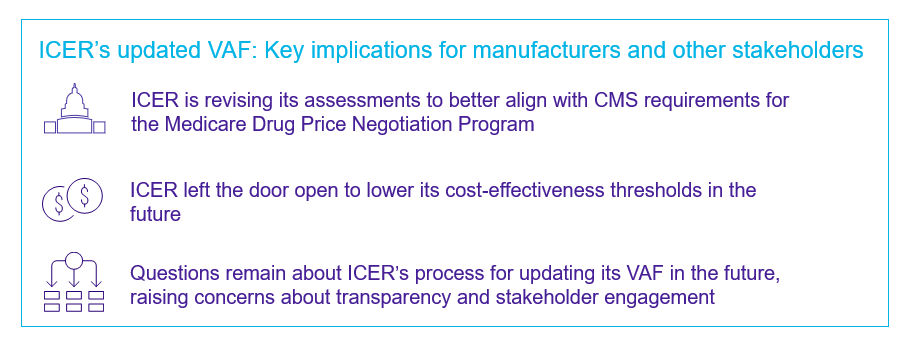The more things change, the more they stay the same? Reviewing ICER's revised value assessment framework
By Kimberly Westrich, MA, Lisabeth Buelt, MPH

Unlike many European countries, the United States (US) does not have a national health technology assessment (HTA) body that conducts mandatory value assessments of healthcare treatments, devices, and services. Instead, US healthcare decision-makers rely on multiple sources of value assessment information to guide their coverage and formulary decisions, including the Institute for Clinical and Economic Review (ICER)’s evidence reports. ICER publishes approximately 8 to 10 evidence reports per year that evaluate the comparative clinical value and cost-effectiveness of emerging pharmaceutical treatments.
Over time, ICER’s evidence reports have gained increasing traction with US healthcare payers and policymakers. A recent Cencora survey of 48 US healthcare payers found that US payers regard ICER’s evidence reports to be among the most useful sources of value assessment information, with 31% reporting that they use ICER reports to inform many or most of their organization’s coverage and formulary decisions.
ICER’s value assessment framework (VAF) provides the methodological foundation for ICER’s individual evidence reports and includes detailed information about the assessment process to ensure ICER’s analyses follow a standardized approach. ICER periodically updates its VAF to account for changes in the broader policy landscape and refine its methods for conducting assessments.
In June 2023, ICER released proposed changes to its VAF and allowed stakeholders 25 days to provide public comments. On September 25, ICER released its final VAF, which it will use to inform its assessments launched after October 2023. Comments were received from 32 stakeholder organizations, including 14 biopharma manufacturers, 8 patient groups, 4 research organizations, 3 industry trade organizations, 2 consultants, and 1 anonymous stakeholder.
Given the role of ICER’s value assessments in US payer decision-making, and the (mis)perception by some that ICER is the de facto US HTA body, it is important to examine the methodological and process changes that ICER will implement in its future reports.
Key changes to ICER’s VAF
Overall, ICER’s revised VAF largely reflects its previous 2020-2023 version, as ICER declined to make substantive changes to its quantitative analyses and methodological inputs. However, ICER’s final framework does include 5 notable changes to its methods and processes that stakeholders should be aware of moving forward.
-
Enhancements to the Patient Engagement Program
ICER’s updated VAF incorporates changes to enhance its Patient Engagement Program, including providing honoraria to patient representatives to help address financial barriers that may hinder participation. ICER will also convene a Patient Counsel to advise and strengthen ICER’s current Patient Engagement Program. - Inclusion of new health equity considerations
In its updated VAF, ICER formalized the inclusion of some of the recommendations included in its March 2023 white paper on Advancing Health Technology Assessment Methods that Support Health Equity. Notably, ICER’s future evidence reports will incorporate clinical trial diversity ratings, which will rely on ICER-developed methods to assess the demographic diversity of clinical trials. - Inclusion of quantitative productivity data
It is often difficult for clinical trials to gather data on a treatment’s potential to improve patient and caregiver productivity, including the ability of patients to return to their full work and family activities. Because productivity is a critical component when considering a treatment’s value to patients, ICER will now include “non-zero” productivity data in its analyses that use a modified societal perspective to ensure a treatment’s impact on productivity is accounted for even when data are not readily available. - Modifications to its Appraisal Committee voting process and questions
In its final VAF, ICER declined to make changes that would quantitatively incorporate additional elements of value despite robust multi-stakeholder recommendations to do so. Instead, ICER will qualitatively capture 4 dimensions of value, including unmet need, caregiver quality of life and productivity, and 2 health equity considerations, in the rebranded “Benefits Beyond Health” and “Special Ethical Priorities” sections. As ICER’s definition of value previously incorporated several additional attributes, several stakeholders expressed concern that changes to ICER’s appraisal committee voting questions represent a narrowing of the definition. - Codification of the shared savings scenarios
The final VAF also codifies ICER’s shared savings analyses, which were initially introduced as exploratory scenarios in ICER’s 2019 methods adaptations for assessing single- and short-term therapies. When assessing treatments with substantial cost offsets, ICER applies one of the following shared savings models: 1) a model in which 50% of the lifetime health system cost offsets from a new treatment are awarded to the new treatment and 50% are “assigned” to the health system (ie, excluded from the cost-effectiveness analysis); and 2) a cap model in which the health system cost offsets generated by a new treatment are capped at $150,000 per year. Methodological limitations to ICER’s shared saving scenarios are well documented.
Despite ICER acknowledging that “most commenters opposed the ongoing use of shared savings scenarios,” ICER’s final VAF stipulates that the shared savings scenarios may now be used to calculate health benefit price benchmarks (HBPBs) when 2 criteria are met: 1) a large percentage of the value-based price comes from cost offsets of a comparator (“large” is not defined by ICER); or 2) the comparator therapy prices are not known to meet common cost-effectiveness thresholds.
Implications for manufacturers and other stakeholders
In addition to formal updates to its methods and processes, ICER’s final VAF includes language that portends potential future changes that will have significant implications for manufacturers and other stakeholders.
First, ICER’s updated framework includes multiple signals that ICER is positioning its assessments to appeal to the Centers for Medicare & Medicaid Services (CMS) as the agency implements the Medicare Drug Price Negotiation Program (MDPNP). For example, ICER removed significant portions of text that previously justified the use of the quality-adjusted life-year (QALY), as ICER’s assessments have historically primarily focused on QALY-based cost-effectiveness analyses (CEAs). In contrast, ICER’s updated framework cites the equal value life-year gained (evLYG) as the usual measure of health gain included in its assessments. Given that the MDPNP prohibits the use of QALY-based CEAs, it is possible that ICER made this change to increase the relevance of its assessments for a CMS audience. Additionally, ICER initially proposed to conduct dynamic pricing scenarios related to the MDPNP. However, ICER’s updated VAF did not formalize this change, citing stakeholder opposition and methodological limitations. Instead, ICER committed to engaging stakeholders to assess the feasibility of conducting these analyses in the future. As ICER continues to evolve its assessments to better align with CMS’ decision context, it will be important for stakeholders, including patient groups and manufacturers, to monitor ICER’s assessments and hold decision-makers accountable for applying appropriate, evidence-based methods.
Second, the updated VAF hints that ICER may reduce its cost-effectiveness thresholds in the future. Despite ICER recognizing that stakeholders’ public comments “generally opposed any consideration of lower cost-effectiveness thresholds as the foundation for HBPBs,” ICER’s final framework opens the door to future changes to its thresholds, suggesting a case could be made to lower the cost-effectiveness threshold range from the current $100,000-$150,000 per QALY/evLYG to $50,000-$100,000. The potential consequences for patients of undervaluing assessed treatments due to artificially low thresholds underscore the importance of stakeholder engagement on this issue.
Third, many questions remain regarding ICER’s process for updating its VAF in the future. ICER initially proposed to publish information about its assessment processes on an ad hoc basis and suggested it would no longer follow the standard 3-year update cycle to which it had previously adhered. However, ICER did not include this proposal in its updated VAF and instead removed all mention related to the timeline and process for future VAF updates. Additionally, ICER states in its updated VAF that it may make interim updates to its framework to incorporate new dynamic pricing scenarios or to adjust its cost-effectiveness thresholds. Such language introduces concern that ICER may make these changes without engaging stakeholders or offering an opportunity for public comment. The lack of knowledge about future VAF updates underscores the need for manufacturers to stay up to date on ICER’s activity.

Looking ahead
Understanding the changes ICER has made to its VAF and the resultant implications for its future assessments will be critical for manufacturers as they plan their future ICER engagement strategies. It will also be important to monitor ICER’s application of its framework to identify potential opportunities for evidence generation related to clinical trial diversity or the inclusion of additional value elements.
Institute for Clinical and Economic Review. 2023 value assessment framework proposed changes. June 5, 2023. Accessed October 12, 2023. https://icer.org/wp-content/uploads/2023/06/Proposed-VAF-Changes-For-Public-Comment_For-Publication_06052023.pdf
Institute for Clinical and Economic Review. 2023 value assessment framework response to public comments. September 25, 2023. Accessed October 12, 2023. https://icer.org/wp-content/uploads/2023/09/ICER-2023-VAF-Response-to-Comments_ForPublication.pdf
Institute for Clinical and Economic Review. Adapted value assessment methods for high-impact “single and short-term therapies.” November 12, 2019. Accessed October 12, 2023. https://icer.org/wp-content/uploads/2020/10/ICER_SST_FinalAdaptations_111219.pdf
Institute for Clinical and Economic Review. Advancing health technology assessment methods that support health equity. March 15, 2023. Accessed October 12, 2023. https://icer.org/wp-content/uploads/2022/07/ICER_Advancing-Health-Technology-Assessment-Methods-that-Support-Health-Equity_040523.pdf
Institute for Clinical and Economic Review. Value assessment framework. Updated September 25, 2023. Accessed October 12, 2023. https://icer.org/wp-content/uploads/2023/09/ICER_2023_VAF_For-Publication_092523.pdf
Optimizing value assessment tools for coverage and reimbursement decisions: promises and pitfalls. AMCP Nexus 2023 conference; October 16-19, 2023; Orlando, FL.
Westrich K, Buelt L. The cures conundrum: the importance of getting value assessment right for transformational therapies. HTA Quarterly. August 9, 2023. Accessed October 12, 2023. https://www.amerisourcebergen.com/insights/manufacturers/htaq-fall-2023-the-cures-conundrum






